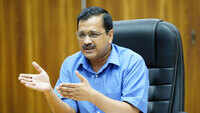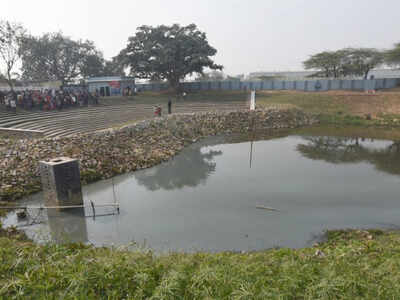
NEW DELHI: To expedite its ambitious-but-slow-paced City of Lakes project, Delhi Jal Board (DJB) has approved a standard set of operating procedures (SOPs) for any plan to rejuvenate waterbodies.
Instead of taking up the projects individually, 30-50 waterbodies of similar parameters will be clubbed under a package and projects will be executed after floating bids in parallel, said a DJB official.
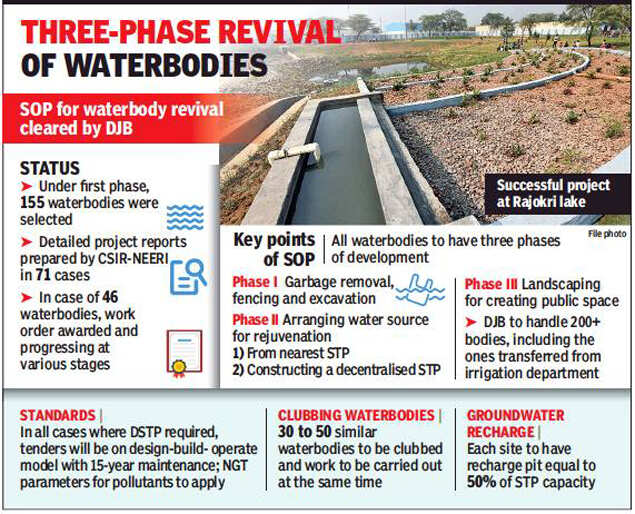
A standard 10-step guideline has been formulated, which “is in line with the model established in creating school rooms and mohalla clinics” the official said. “Over 20,000 classrooms and hundreds of mohalla clinics were built after following SOPs. We want to standardise and replicate the same for waterbodies.”
The SOPs set priority timelines for garbage removal and desilting of lake beds followed by landscaping of surroundings to create a public space. The board has approved a three-phase development for all waterbodies.
Garbage removal, fencing and excavation of lake bed will be carried out in phase-I, followed by arrangement of water source for rejuvenation from the nearest sewage treatment plant (STP) or through construction of an on-site decentralised STP (DSTP) for treating waste water. Phase-III will involve landscaping of surroundings at each of the 201 sites.
“In all cases where DSTP are required, tenders will be floated on the design-build-operate model with 15-year maintenance and NGT-fixed parameters for pollutants. Each site should have a recharge pit equal to 50% of the STP capacity to increase groundwater recharge,” the norms state.
In the first phase of the City of Lakes project, conceived around three years ago, 155 waterbodies were to be revived. While project reports have been prepared by CSIR-NEERI for 71 waterbodies, works orders have been issued in 46 cases. “Work at 50 sites is at different stages like digging lake bed, setting up tanks, and reclamation of land by local SDMs from encroachers,” the official said. The work is 70-80% complete in case of eight waterbodies. “The commissioning can be done after introducing gravel in DSTP.”
According to DJB, the progress will be faster now. “The target is to finish the first phase in the next two years. We have seen a slow place in the past three years, with just five-six waterbodies being taken up every year,” the official said.
With the broad parameters fixed now, “we will provide land area, status, groundwater levels, quality of water etc and there will be flexibility in terms of choosing any proven technology for water treatment”, he added.
Instead of taking up the projects individually, 30-50 waterbodies of similar parameters will be clubbed under a package and projects will be executed after floating bids in parallel, said a DJB official.

A standard 10-step guideline has been formulated, which “is in line with the model established in creating school rooms and mohalla clinics” the official said. “Over 20,000 classrooms and hundreds of mohalla clinics were built after following SOPs. We want to standardise and replicate the same for waterbodies.”
The SOPs set priority timelines for garbage removal and desilting of lake beds followed by landscaping of surroundings to create a public space. The board has approved a three-phase development for all waterbodies.
Garbage removal, fencing and excavation of lake bed will be carried out in phase-I, followed by arrangement of water source for rejuvenation from the nearest sewage treatment plant (STP) or through construction of an on-site decentralised STP (DSTP) for treating waste water. Phase-III will involve landscaping of surroundings at each of the 201 sites.
“In all cases where DSTP are required, tenders will be floated on the design-build-operate model with 15-year maintenance and NGT-fixed parameters for pollutants. Each site should have a recharge pit equal to 50% of the STP capacity to increase groundwater recharge,” the norms state.
In the first phase of the City of Lakes project, conceived around three years ago, 155 waterbodies were to be revived. While project reports have been prepared by CSIR-NEERI for 71 waterbodies, works orders have been issued in 46 cases. “Work at 50 sites is at different stages like digging lake bed, setting up tanks, and reclamation of land by local SDMs from encroachers,” the official said. The work is 70-80% complete in case of eight waterbodies. “The commissioning can be done after introducing gravel in DSTP.”
According to DJB, the progress will be faster now. “The target is to finish the first phase in the next two years. We have seen a slow place in the past three years, with just five-six waterbodies being taken up every year,” the official said.
With the broad parameters fixed now, “we will provide land area, status, groundwater levels, quality of water etc and there will be flexibility in terms of choosing any proven technology for water treatment”, he added.

Coronavirus outbreak
Trending Topics
LATEST VIDEOS
City
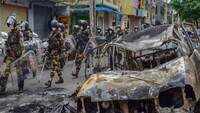 Bengaluru riots: Crime Branch files chargesheet, names ex-Congress mayor Sampath Raj as accused
Bengaluru riots: Crime Branch files chargesheet, names ex-Congress mayor Sampath Raj as accused  Bihar polls: BJP expels nine party leaders who joined LJP
Bihar polls: BJP expels nine party leaders who joined LJP 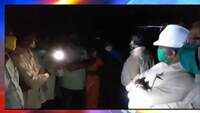 Vizag locals in panic after reports of alleged gas leak from plant; officials confirm ‘no leakage’
Vizag locals in panic after reports of alleged gas leak from plant; officials confirm ‘no leakage’ 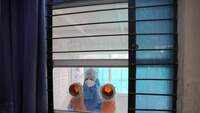 Covid-19: India records lowest fresh cases in 63 days and lowest casualties in 77 days
Covid-19: India records lowest fresh cases in 63 days and lowest casualties in 77 days
More from TOI
Navbharat Times
Featured Today in Travel
Get the app
